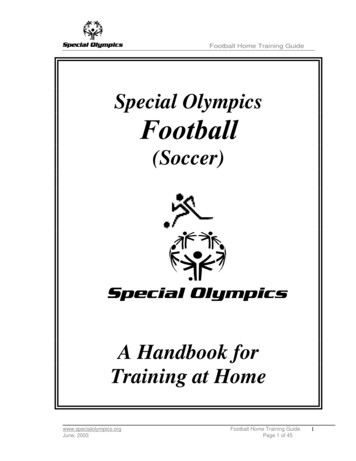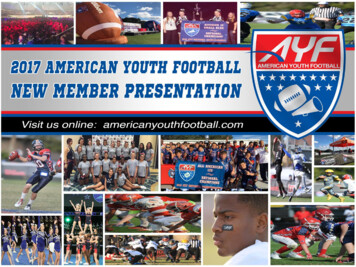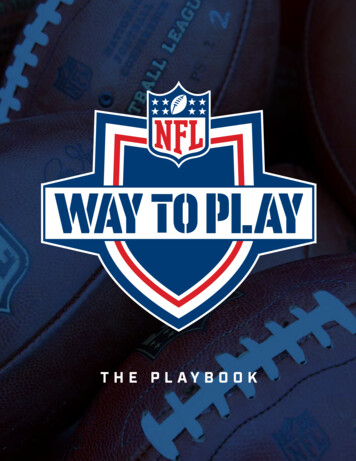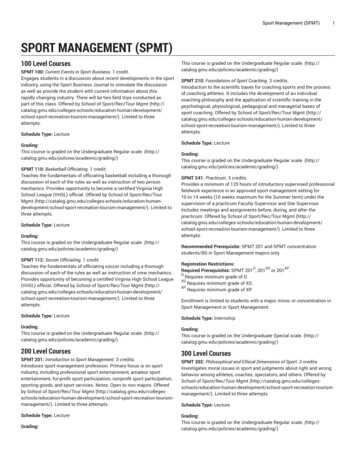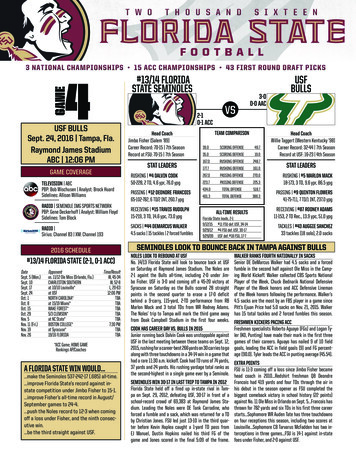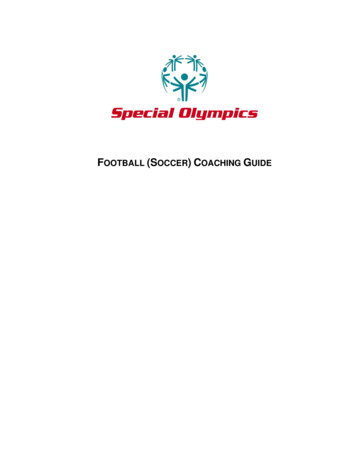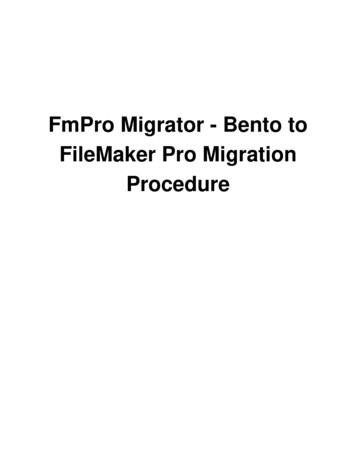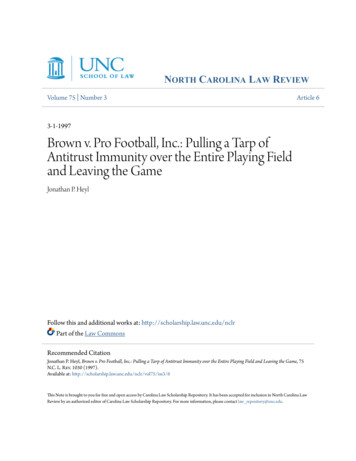
Transcription
NORTH CAROLINA LAW REVIEWVolume 75 Number 3Article 63-1-1997Brown v. Pro Football, Inc.: Pulling a Tarp ofAntitrust Immunity over the Entire Playing Fieldand Leaving the GameJonathan P. HeylFollow this and additional works at: http://scholarship.law.unc.edu/nclrPart of the Law CommonsRecommended CitationJonathan P. Heyl, Brown v. Pro Football, Inc.: Pulling a Tarp of Antitrust Immunity over the Entire Playing Field and Leaving the Game, 75N.C. L. Rev. 1030 (1997).Available at: is Note is brought to you for free and open access by Carolina Law Scholarship Repository. It has been accepted for inclusion in North Carolina LawReview by an authorized editor of Carolina Law Scholarship Repository. For more information, please contact law repository@unc.edu.
Brown v. Pro Football, Inc.: Pulling a Tarp of AntitrustImmunity over the Entire Playing Field and Leaving the GameThroughout this century, courts have struggled in their attemptto harmonize the often-conflicting policies of labor relations and antitrust protectionWhile labor policy favors the formation ofcollective bargaining agreements between labor and management,2with disputes between the two parties being resolved by the NationalLabor Relations Board (the "NLRB") rather than the courts,3 thoseagreements often contain terms that restrain trade in violation of theSherman Antitrust Act. The primary difficulty faced by the courtshas been determining whether and when to intervene in labor relations and apply antitrust law to situations which labor laws allow oreven encourage.In a recent class action brought by professional football players,the Supreme Court once again addressed the conflict between laborpolicy and antitrust law. After the expiration of a collective bargaining agreement in 1987, the National Football League (the "NFL"or the "League") and the National Football League Players Association ("the players" or "the Players Association") were unable toreach a new agreement In 1989, still operating without an agreement, the League proposed a plan that would allow each team tocarry a "developmental squad" of six players on its roster, with eachplayer on the squad to be paid a fixed salary.6 When the players re1. See infra notes 82-239 and accompanying text; see also Douglas L. Leslie, Principles of Labor Antitrust, 66 VA. L. REV. 1183, 1184 (1980) ("Accommodating antitrustpolicy and labor policy is not an easy task. The conflict between the two is fundamental:the antitrust statutes promote competition and economic efficiency, while the federallabor statutes sanction activity that is arguably anticompetitive."); Bernard D. Meltzer,Labor Unions, Collective Bargaining,and the Antitrust Laws, 32 U. CHI. L. REV. 659, 678(1965) (referring to the "uncertainties that fundamentally arise from the absence of aprinciple for harmonizing the conflict between the policy of commercial competition andof collective bargaining").2. See 29 U.S.C. §§ 151, 157-58 (1994).3. See id. §§ 153, 156; Charles D. Bonanno Linen Serv., Inc. v. NLRB, 454 U.S. 404,413 (1982); NLRB v. Truck Drivers Local Union No. 449,353 U.S. 87,96 (1957).4. See 15 U.S.C. § 1 (1994) ("Every contract, combination in the form of trust orotherwise, or conspiracy, in restraint of trade or commerce among the several States, orwith foreign nations, is declared to be illegal.").5. See Brown v. Pro Football, Inc., 782 F. Supp. 125, 129 (D.D.C. 1991), rev'd, 50F.3d 1041 (D.C. Cir. 1995), affd, 116 S. Ct. 2116 (1996).6. See id. at 127.
19971ANTITRUST IMMUNITY1031fused to agree to this plan, the League determined that a bargainingimpasse had been reached and unilaterally implemented the proposalover the objections of the players.7 In Brown v. Pro Football, Inc.,8the Supreme Court held that the League's actions were shielded fromantitrust liability by the judicially created "nonstatutory labor exemption" to the antitrust laws.9This Note discusses the facts of Brown, its history in the lowercourts, and the Supreme Court's resolution of the issues presented bythe case. 0 The Note then examines the history of the interplay between labor and antitrust law, the courts' confusion concerning theirrole in the interplay, and the evolution of the judicial "nonstatutorylabor exemption" to antitrust law.11 It also addresses how the courtshave dealt with the scope of the exemption in recent years, particularly regarding the duration of the exemption and the range ofexempt actions. Finally, the Note discusses the possible ramifications of the Court's decision, its relation to precedent, and thepossible motivation behind the Court's repositioning in regard to labor issues.The NFL was in its second year without a collective bargainingagreement when the team owners voted to adopt Resolution G-2 inthe spring of 1989.14 The resolution, developed by the League's plan7. See id. at 128.8. 116 S. Ct. 2116 (1996).9. See id. at 2121. Although the principle had been applied in earlier cases, theCourt first expressly recognized the "nonstatutory labor exemption" from the antitrustlaws in Connell Construction Co. v. Plumbers & Steamfitters Local Union No. 100, 421U.S. 616 (1975). The Connell Court noted that unions enjoyed a statutory exemptionfrom antitrust liability because labor statutes declared that unions are not "combinationsor conspiracies in restraint of trade," and exempted certain union activity from antitrustliability. Connell, 421 U.S. at 621-22 (citing 15 U.S.C. § 17 (1994); 29 U.S.C. §§ 52, 104-05(1994)). However, nothing in the statutes specifically exempted concerted action between unions and management, which meant that the collective bargaining agreementsbetween the two were not statutorily protected from antitrust liability. See id. at 622. Inorder to remedy this situation, the Court stated that "a proper accommodation betweenthe congressional policy favoring collective bargaining under the [National Labor Rela-tions Act] and the congressional policy favoring free competition in business marketsrequires that some union-employer agreements be accordeda limited nonstatutory exemption from antitrust sanctions." Id.(emphasis added).10. See infranotes 14-81 and accompanying text.11. See infranotes 82-194 and accompanying text.12. See infranotes 195-239 and accompanying text.13. See infra notes 240-368 and accompanying text.14. See Brown, 116 S.Ct. at 2119. Due to the history of labor disputes in the NFL,"long and difficult negotiations over a new collective bargaining agreement" were expected. Ethan Lock, The Scope of the Labor Exemption in Professional Sports, 1989DuKE L.J. 339, 339. In an unsuccessful attempt to prompt a new agreement, the players
1032NORTH CAROLINA LAW REVIEW[Vol. 75ning committee,' grew out of the concern that certain team ownerswere attempting to evade roster limits by "stashing" players on theinjured reserve list.16 The League's solution was to allow each teamto have a developmental squad of six first-year players who wouldpractice with the team and occasionally substitute for injured players.17 The players would be paid a fixed, League-mandated salary of 1,000 per week and individual negotiations with such players were"not permitted.'.There had been no similar arrangement in the recently expired1982-1987 agreement, which had expressly given each player the rightto individually negotiate his own salary. 9 The players adamantly refused to relinquish this right and made clear that they would notsubmit to an agreement permitting the League to set the salaries ofcertain players." In June of 1989, the League concluded that a bargaining impasse had been reached in regard to the proposal,' and itunilaterally implemented Resolution G-2 when the season began thatSeptember." A number of players from the developmental squadsbrought an antitrust class action suit against the League in the springof 1990.2The district court granted summary judgment in favor of theplayers on the issue of whether the NFL's actions were shielded fromantitrust liability by the "nonstatutory labor exemption." 24 The courtconducted a strike for 24 days at the beginning of the 1987 season. See id. at 340 & n.8.15. See Brown v. Pro Football, Inc., 782 F. Supp. 125, 127 (D.D.C. 1991), rev'd, 50F.3d 1041 (D.C. Cir. 1995), affd, 116 S. Ct. 2116 (1996).16. See Brown v. Pro Football, Inc., 50 F.3d 1041, 1069 (D.C. Cir. 1995) (Wald, J.,dissenting), affd, 116 S.Ct. 2116 (1996).17. See Brown, 116 S. Ct. at 2119.18. Brown, 782 F. Supp. at 128.19. See Brown, 116 S. Ct. at 2130 n.3 (Stevens, J., dissenting). Justice Stevens notedthat the League's decision to fix the salaries of the developmental squad players was aparticularly significant departure from prior practice because the individual negotiation ofplayers' salaries had "prevailed even prior to collective bargaining." Id. at 2130 (Stevens,J., dissenting).20. See Brown, 782 F. Supp. at 128. Eugene Upshaw, the representative of the players union, sent a letter to the League stating the union's stance that " 'all players,including developmental, should have the right to negotiate salary terms, and that nofixed wage for any group of players is acceptable to the [players union].'" Id.21. See id. The "bargaining" over the proposal consisted of one meeting and severalletters and phone calls over the course of several months. See id. at 127-28.22. See id. at 128. In September, Pete Rozelle, the Commissioner of the NFL, sent amemorandum to each NFL team, reiterating the salary terms of developmental squadplayers and warning against individual negotiations with the players or the provision ofcompensatory perquisites. See id.23. See id.24. See id. at 131; see also supra note 9 (discussing the nonstatutory exemption).
1997]ANTITRUST IMMUNITY1033explained that the nonstatutory exemption was created to protectlabor-management agreements from antitrust liability.? The exemption no longer applies when an agreement expires "because thereason for the exemption no longer exists: the union no longeragrees to the restraint and therefore continuation of the restraintviolates the Sherman Act."' The jury trial that followed resulted in atreble-damage award of over 30,000,000 against the NFL.27A divided panel of the Court of Appeals for the District of Columbia Circuit reversed? The court stated that the case called for adetermination of "whether the nation's labor laws or antitrust policycontrol[led],, 29 and concluded that the dictates of labor policy tookprecedence over the considerations of antitrust law? Because the25. See Brown, 782 F. Supp. at 132. The district court quoted language from ConnellConstruction Co. v. Plumbers & Steamfitters Local Union No. 100, 421 U.S. 616, 621-22(1975), stating that labor policy requires that" 'some union-employer agreements be accorded a limited nonstatutory exemption from antitrust liability.' " Brown, 782 F. Supp.at 130 (alteration in original).26. Brown, 782 F. Supp. at 132. The court alternatively held that if the exemption didnot expire with the agreement, then it expired at impasse. See id. at 134. Noting thatsome authority favored extending the exemption beyond expiration of the agreement, thedistrict court conceded that it understood the policy promoted by such an approachnamely, the provision of a non-coercive atmosphere in which the parties could try toreach a new agreement without the employer fearing antitrust liability. See id at 135.The district court explained, however, that when negotiations toward a new agreementstalled at impasse, extension of the exemption beyond that point simply allowed the employer to force unagreed-upon terms on the union; thus, new agreements would be lesslikely to be reached because the employer would favor bargaining to impasse. See i&t at135-36.Yet another alternative holding was that the nonstatutory exemption did not apply atall because the NFL had implemented terms that had not been in the expired collectivebargaining agreement. See id-at 137. Again, the district court embraced the idea that theexemption pertained to certain agreements, see id at 138, and reasoned that there was nobasis for extending it to cover the imposition of terms to which one party had neveragreed. See id. at 138-39.27. See Brown, 116 S. Ct. at 2119.28. See Brown v. Pro Football, Inc., 50 F.3d 1041, 1058 (D.C. Cir. 1995), aff'd, 116 S.Ct. 2116 (1996).29. Id. at 1045.30. See id. at 1056. The court of appeals noted that the National Labor RelationsAct, see 29 U.S.C. §§ 151-69 (1994), had not been interpreted as forbidding employersfrom making unilateral changes after impasse, provided those changes were proposed inpre-impasse bargaining. See Brown, 50 F.3d at 1051. The court also noted that laborpolicy provides both unions and employers with economic weapons, and that allowing theunions the ability to bring antitrust claims would give them a "powerful new weapon" thatwould distort the carefully created balance. Id at 1052. Furthermore, the court statedthat antitrust law should be applied primarily to restraints in a product market, not a labor market. See id. at 1054. The court therefore concluded that "when federal laborpolicy collides with federal antitrust policy in a labor market organized around a collective bargaining relationship, antitrust policy must give way." Id. at 1056.
1034NORTH CAROLINA LAW REVIEW[Vol. 75labor laws allowed the unilateral imposition of terms after impasse3'and the NFL's actions "primarily affect[ed] only a labor market organized around a collective bargaining relationship,"3 2 the court heldthat the nonstatutory exemption should extend beyond expiration ofthe agreement and beyond impasse in order to protect the "entirecollective bargaining process." 33The Supreme Court affirmed," although it slightly narrowed theappellate court's interpretation of the scope of the exemption. 5 According to the Court, four characteristics made the NFL's actions fallwithin the scope of the "nonstatutory labor exemption:" (1) the actions "took place during and immediately after a collectivebargaining negotiation"; (2) they "grew out of, and [were] directlyrelated to, the lawful operation of the bargaining process"; (3) theyinvolved a mandatory subject of bargaining under the federal laborlaws; and (4) they "concernedonly the parties to the collective36relationship.,bargainingCharacterizing the nonstatutory exemption somewhat differentlythan it had in the past, the Court described it as being applicable"where needed to make the collective-bargaining process work."37The Court reasoned that the exemption was necessary as a matter of"both history and logic." 3 Historically, the Court explained, the exemption reflected Congress's intent that labor laws, not the antitrust31. See Brown, 50 F.3d at 1051.32 Id. at 1048.33. Id. at 1051. The appellate court concluded that "injecting antitrust liability intothe system for resolving disputes between unions and employers would both subvert national labor policy and exaggerate federal antitrust concerns." Id. at 1056.34. See Brown, 116 S. Ct. at 2119. Justice Breyer wrote the majority opinion and wasjoined by Chief Justice Rehnquist and Justices O'Connor, Scalia, Kennedy, Souter, Thomas, and Ginsburg. Justice Stevens wrote a dissenting opinion. See id. at 2128 (Stevens,J., dissenting).35. See id. at 2119. The D.C. Circuit distinguished between antitrust applicability toproduct market restraints and to labor market restraints, see 50 F.3d at 1050-51; supranote 30, and essentially held that all labor market restraints that apply to parties in a collective bargaining relationship are exempt from antitrust scrutiny. See Brown, 50 F.3d at1056. The scope of the exemption as the Supreme Court defined it, although very broad,does not absolutely preclude application of the exemption in a labor context. See infranotes 66-67 and accompanying text.36. Brown, 116 S. Ct. at 2127.37. Id. at 2119. When the Court first expressly recognized the nonstatutory exemption, it described it as applying to "some union-employer agreements." Connell Constr.Co. v. Plumbers & Steamfitters Local Union No. 100, 421 U.S. 616, 622 (1975); see alsosupranote 9 (discussing the nonstatutory exemption).38. Brown, 116 S. Ct. at 2120.
19971ANTITRUST IMMUNITY1035statutes, be used to resolve labor disputes.3 9 Logically, it would beinconsistent to legislatively require labor and management to bargaintogether and then hold their agreements-which often restrain tradein some way-illegal under the antitrust laws.40The Court reasoned that in order to protect the collective bargaining process, the scope of the exemption must be broad and theexemption must apply to employers as well as employees. 41 Havingestablished this, the Court reached the issue of whether the scope wasbroad enough to cover a multi-employer bargaining unit's unilateralimposition of terms after a bargaining impasse.42 The Court concluded that the scope was sufficiently broad to cover such actions.43 Itrecognized that labor law (acting apart from antitrust law) allowsemployers to unilaterally implement new or changed terms after abargaining impasse is reached, provided that those terms were"reasonably comprehended" in the employer's previous proposals'and the employer does not bargain in bad faith.45 The Court notedthat this "reflect[s] the fact that impasse and an accompanying implementation of proposals constitute an integralpart of the bargainingprocess," and thus should be shielded from antitrust liability by thenonstatutory exemption.46As additional support for its conclusion, the Court reasoned thata multi-employer bargaining group would be put in an extremely difficult position if it were potentially subject to antitrust liability afterbargaining reached impasse. 47 If every employer in a multi-employergroup were to impose the same new terms after impasse, they could39. See id. The Court noted that Congress's enactment of labor statutes in 1914 andin the 1930s was designed to keep courts and antitrust law out of "labor disputes." Id.Those statutes, however, focused primarily on preventing employers from using the antitrust laws against the unions. See 15 U.S.C. § 17 (1994); 29 U.S.C. §§ 52, 102, 104, 113(1994).40. See Brown, 116 S. Ct. at 2120. The national labor laws impose an obligation onemployers and employees to bargain collectively regarding "wages, hours, and otherterms and conditions of employment." 29 U.S.C. § 158(d); accord NLRB v. Wooster Div.of Borg-Warner Corp., 356 U.S. 342,349 (1958).41. See Brown, 116 S. Ct. at 2121.42. See iL43. See id.44. See id. (citing Storer Communications, Inc., 294 N.L.R.B. 1056, 1090 (1989); TaftBroad. Co., 163 N.L.R.B. 475,478 (1967), enforced, 395 F.2d 622 (D.C. Cir. 1968)).45. See id. (citing Akron Novelty Mfg. Co., 224 N.L.R.B. 998, 1002 (1976)).46. Id (emphasis added); see infra notes 307-19 and accompanying text (discussingdifferent views on whether impasse and the subsequent unilateral imposition of terms arepart of the "bargaining process").47. See Brown, 116 S. Ct. at 2122-23.
1036NORTH CAROLINA LAW REVIEW[Vol. 75each be liable under antitrust laws.' If any employer separated fromthe group and imposed different terms, that employer would be subject to an unfair labor practice charge under the labor laws.49 Finally,if all the employers simply maintained the status quo by continuing tooperate according to the terms of the expired agreement, and theunion thought those terms were unfavorable, the employers couldagain face antitrust liability if there was evidence that they acted inconcert. "All this is to say that to permit antitrust liability [in thecontext of labor negotiations] threatens to introduce instability anduncertainty into the collective-bargaining process" because antitrustlaw often forbids what collective bargaining requires."1The Court stated that although the above problem could theoretically be solved by allowing "antitrust courts"52 to determine thereasonableness of employers' actions on a case-by-case basis, such acourse was impractical. 3 It would result in "a web of detailed rules''spun by many different nonexpert antitrust judges and juries,"rather than a cohesive set of rules created by the NLRB.55 The Courtstressed that the NLRB was composed of experts in the field and that48. See id. The antitrust liability would arise from the fact that the individual employers were acting identically, and their "prior or accompanying conversations"-that is,their collective proposal of terms during the prior bargaining process or their discussionsover which new terms to implement-would evidence a "common understanding oragreement." Id. at 2123. Presumably, this would allow the employers to be characterizedas a combination or conspiracy in restraint of trade.49. See id Labor law deems it an unfair labor practice for an employer to "interferewith, restrain, or coerce employees in the exercise of their rights [to collectively bargain]," 29 U.S.C. § 158(a)(1) (1994), and to "refuse to bargain collectively with therepresentatives of his employees," id. § 158(a)(5). In Charles D. Bonanno Linen Service,Inc. v. NLRB, 454 U.S. 404 (1982), the Court held that an employer had violated thesesections and committed an unfair labor practice when it withdrew from a multi-employerbargaining group after impasse and refused to abide by the agreement that was subsequently reached between the union and the remaining employers in the group. See id. at406. The Court endorsed the NLRB's position that "an impasse is not an unusual circumstance justifying [an employer's] withdrawal" from a multi-employer bargaining unit. hLat 412.50. See Brown, 116 S. Ct. at 2123.51. Id.52. The Court used this term at several points in the opinion, see, e.g., id. at 2122,2125, presumably to emphasize the distinction between courts that are capable of applying antitrust law and the NLRB, which reviews and attempts to resolve labor disputeswithin the confines of labor law.53. See id. at 2123.54. Id.55. See id The NLRB was created in 1935 by the National Labor Relations Act(Wagner Act), ch. 372, § 3, 49 Stat. 449, 451 (1935) (codified as amended at 29 U.S.C.§ 153 (1994)). The NLRB's functions include overseeing the collective bargaining processand addressing complaints of unfair labor practices.
1997]ANTITRUST IMMUNITY1037Congress intended that the NLRB, rather than the courts, overseethe collective bargaining process.56 One of the objectives of the laborlaws "was to take from antitrust courts the authority to determine .what'' is socially or economically desirable collective-bargaining policy. 5The Court rejected the contention that "impasse" should be thepoint at which the exemption expires, reiterating that this would putemployers in the aforementioned difficult situation when impasseoccurred. 5 Further, the Court noted that an "impasse" line would bedifficult to draw because" 'impasse' is often temporary" and is oftenmerely one stage in the bargaining process.59 Additionally, it wouldrequire nonexpert courts to determine when impasse had actuallyoccurred, a task for which courts are unsuited and one which shouldbe left to the NLRB."56. See Brown, 116 S.Ct. at 2123, 2125. The Court has shown varying degrees ofdeference to the NLRB in the past. For example, in Local 189, Amalgamated Meat Cutters v. Jewel Tea Co., 381 U.S. 676 (1965) one issue was whether a disputed term was a"term or condition of employment." Id.at 684. Although the union in that case claimedthe issue "was peculiarly within the competence of the Board," id., the Court neverthelessasserted that it had "experience in classifying bargaining subjects" and had jurisdictionover the case, id. at 686.In CharlesD. Bonanno Linen Service, Inc. v. NLRB, 454 U.S. 404 (1982), the Courtdisplayed more deference, supporting an NLRB finding and stating that "the dissentingJustices would have us substitute our judgment for those of the Board with respect to theissues that Congress intended the Board to have." Id, at 418. In dissent, Chief JusticeBurger, joined by then-Associate Justice Rehnquist, argued that "[t]he Court's deferral tothe Board's conclusion that its rules advance thd national labor policy .represents justthe kind of uncritical judicial rubber stamping we have often condemned." Id. at 423(Burger, C.J., dissenting). Although Chief Justice Rehnquist was part of the Brown majority that appeared to adopt a somewhat different stance, it is perhaps relevant that, inBonanno, Justice Rehnquist supported an argument to allow employers " 'self-help .when legitimate interests of employees and employers collide.'" Id.at 422 (Burger, C.,dissenting) (quoting NLRB v. Truck Drivers Local 449, 353 U.S. 87, 96 (1957)). For adiscussion of Truck Drivers, see infra note 150.57. Brown, 116 S. Ct. at 2123.58. See id. at 2124; see also supra notes 47-51 and accompanying text (discussing theattributes of this difficult situation).59. Brown, 116 S. Ct. at 2124-25; see also infra notes 307-11 and accompanying text(discussing "impasse" and its significance in regard to the bargaining process and the duration of the nonstatutory exemption).60. See Brown, 116 S. Ct. at 2125. The Court also rejected the suggestion that theexemption should be extended beyond impasse only in certain circumstances-for example, when the employer needs time to obtain legal advice as to whether impasse hasactually occurred, or when the employer engages in a lockout, which is allowed under thelabor laws. See id. The Court noted that even such a "softened" rule would still involvecourts in the bargaining process, leaving employers in the unenviable position of having todesign their bargaining strategies based on "what they predict or fear that antitrust courts,not labor law administrators, will eventually decide." Id.
1038NORTH CAROLINA LAW REVIEW[Vol. 75The Court also rejected the proposal that employers' postimpasse tactics should be exempt, but not their post-impasse tenns."Stating that "the imposition of 'terms' [is often] a bargaining'tactic,'" the Court noted that such a rule would require nonexpertcourts to make an "amorphous" inquiry into employers' subjectivemotives.' The Court repeated its concerns about performing such arole and suggested that the collective bargaining process was no placeto have courts and judges" 'roaming at large.' "'Finally, the Court made clear that professional sports cases didnot merit "special" treatment under the collective bargaining system.' Noting that "it would be odd to fashion an antitrust exemptionthat gave additional advantages to professional football players," theCourt concluded that the players were indistinguishable from otherworkers and thus "must abide by the same legal rules.""Although the Court's holding extends the nonstatutory exemption beyond impasse and covers the post-impasse unilateralimposition of terms by employers, the Court stated in dicta that itwas possible that some impositions may not be immune from antitrust laws." If the actions of employers were "sufficiently distant intime and in circumstances from the collective-bargaining process,"and applying antitrust law would not interfere with the bargainingprocess, then the application of such law may be appropriate." Shortof such a situation, however, the bargaining process and labor relations presumably would be beyond the reach of "antitrust courts."61. See id.62. Id.63. Id. at 2126 (quoting Local 189, Amalgamated Meat Cutters v. Jewel Tea Co., 381U.S. 676,716 (1965) (separate opinion of Goldberg, J.)).64. See id. The players argued that regardless of how the nonstatutory exemptionapplied in other collective bargaining relationships, the unique characteristics of professional sports warranted different legal rules. See id.; infra note 213. In particular,professional athletes fare better by negotiating their salaries individually, whereas inother labor contexts the employees benefit from being able to collectively negotiate uniform wage levels. See Brown, 116 S. Ct. at 2126. Compare Lock, supra note 14, at 409(arguing that professional sports merit special treatment under the labor laws), with Michael S. Jacobs & Ralph K. Winter, Jr., Antitrust Principlesand Collective BargainingbyAthletes: Of Superstarsin Peonage, 81 YALE L.J. 1, 9 (1971) (arguing that unions of professional athletes should not be treated differently than other unions under the antitrustand labor laws).65. Brown, 116 S.Ct. at 2126.66. See id,at 2127.67. Id. The Court suggested that if a collective bargaining relationship "collapsed,"perhaps due to the decertification of a union or the disintegration of a multi-employerbargaining unit, then perhaps antitrust law would be applicable. See id. For a discussionof union decertification, see infra notes 284-91 and accompanying text.
1997]ANTITRUST IMMUNITY1039In dissent, Justice Stevens argued that the broad scope of the exemption as defined by the majority would frustrate national laborpolicy." He noted that while antitrust law serves to ensure free competition and the resulting optimal price levels, 9 it is the policy ofnational labor legislation to prevent such competition among jobseeking laborers in the interest of avoiding depressed wages." Thus,the labor statutes exempt union activity from antitrust liability in aneffort to give laborers more bargaining power through collective action, allowing them to negotiate for higher wage levels than theywould obtain in a "free" labor market.7 ' In the same vein, the judicialnonstatutory exemption protects the agreements these unions reachwith employers from antitrust sanctions.' Justice Stevens concludedthat fashioning an exemption that allows employers to collectivelytake actions that depress wages below free market levels is not supported by the policies of either labor or antitrust law.'Justice Stevens further argued that the case had unique featuresand that the majority erred in treating the case as a t
Construction Co. v. Plumbers & Steamfitters Local Union No. 100, 421 U.S. 616, 621-22 (1975), stating that labor policy requires that" 'some union-employer agreements be ac-corded a limited nonstatutory exemption from antitrust liability.' " Brown, 782 F. Supp. at 130 (alteration in original). 26. Brown, 782 F. Supp. at 132.
